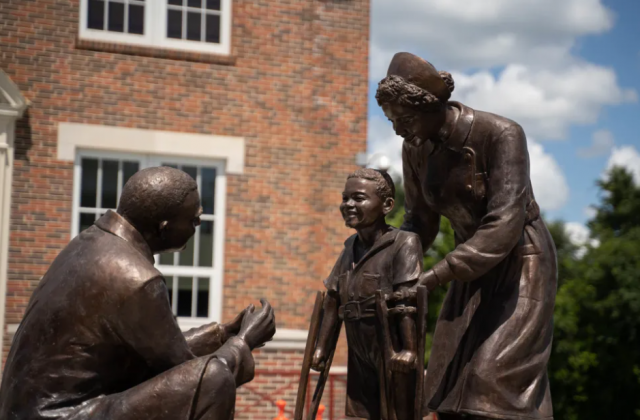
By Gabby Gervais
bhamnow.com
A life-size bronze monument was unveiled at Tuskegee University recently to honor the significant research conducted at Tuskegee Infantile Paralysis Center to eradicate polio.
Decades ago, Black doctors, researchers and support personnel conducted significant research to eradicate polio at Tuskegee Infantile Paralysis Center.
Now, a bronze statue has been unveiled this month to honor and memorialize their exceptional work.
The statue, provided by fundraising and collaboration of the Rotary Club, depicts Dr. John W. Chenault, nurse Warrena A. Turpin and a young polio patient named Gordon Stewart. They represent the spirit of excellence that was prevalent at the Infantile Paralysis Center during that time.
Family members of former doctors and researchers, Rotary members, leaders of the March of Dimes, Alabama representatives and guest speaker Federal Judge Myron G. Thompson were special guests at the monument unveiling.
Thompson, a Tuskegee native, was diagnosed with polio at the age of two and was bedridden, then confined to a wheelchair before working to recover and walk with just a limp.
The monument stands in front of the museum beside John A. Kenney Hall, in what once was the John A. Andrew Memorial Hospital where the Infantile Paralysis Center treated many young Black polio patients.
According to the University, in the early years of the fight against polio, the Tuskegee Paralysis Center was the only place in the South where Black children with polio could come for treatment.
Rotary International is a global humanitarian organization that brings together business and professional leaders to uplift communities across the world. In 1985, Rotary International and its partners committed to eradicating polio.
The statute was commissioned by the Rotary District 6880, which is a consortium of Alabama Rotary Clubs, with support from the Tuskegee University Archives staff through the Tuskegee Polio Recognition Project.
Dr. Charlotte P. Morris, President, Tuskegee, said, “I’d like to acknowledge the partnership with Rotary District 6880 and its members for their work with the Tuskegee Polio Recognition Project to erect this monument. We are grateful for their acknowledgment of the dedication of Black researchers and doctors to fight the war against polio.”
Tuskegee’s former Board Chair Basil O’Connor, namesake of the major nursing building on campus, was instrumental in creating the National Foundation for Infantile Paralysis, which later became the March of Dimes.
He was a vocal proponent of Tuskegee researchers and their work for the good of our community and the nation, in a segregated America where Black contributions to science and medicine were commonly overlooked.
For more on the modern, mobile guide to Birmingham, visit bhamnow.com



